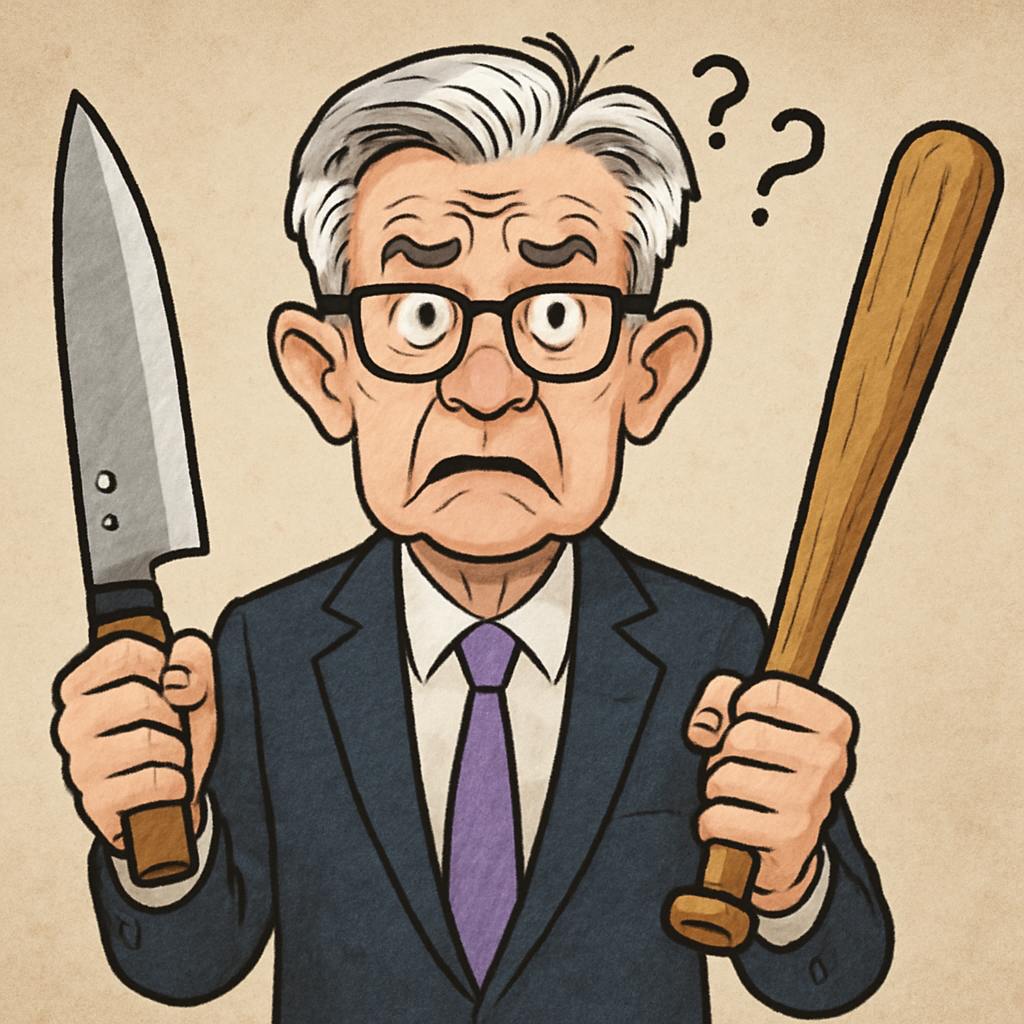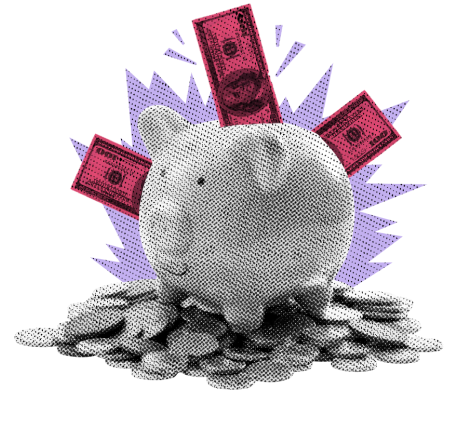A market-savvy breakdown of the Fed’s futile fight against supply-driven inflation.

A market-savvy breakdown of the Fed’s futile fight against supply-driven inflation.
KEY TAKEAWAYS
-
The Fed’s dual mandate includes regulating inflation and maximizing employment
-
Post-COVID inflation began as supply-push and evolved into demand-pull
-
Rate hikes have no effectiveness on supply-driven inflation
-
Tariffs reignite cost-based inflation, not demand-based
-
The Fed’s rate tool is too blunt to address today’s inflation dynamics
MY HOT TAKES
-
Many, even the Fed itself, overestimate the Fed’s control over inflation
-
Tariffs are the real potential inflation threat now, not consumption
-
Monetary policy is a blunt instrument misapplied to a surgical problem
-
Markets, not the Fed, drove inflation normalization in 2023
-
The Fed’s credibility depends on precision, but its blade is dull
-
You can quote me: “The Fed’s preferred tool for controlling the economy is less like a precision blade and more like a baseball bat–not really effective for the exactness that the central bank would purport itself to have.”
Dull edge. I love to cook! I could write an entire book on my joy of cooking, but because that book has already been written, I will respect your time and keep it basic. I will posit to you that it is the only form of art that is practical in the sense that it can nourish you at the end of the day. I enjoy food, but what I enjoy most is the process of its preparation. I really pride myself on my knife skills, which have been painfully (with many wounds) honed (no pun intended) over these past many decades. In my pursuit, I have accumulated a respectable collection of knives–you can say I have a fascination with them. There you go–that’s it. Well, not quite. You see, I love test-driving friends’ and families’ kitchens as part of my pursuit, and one story popped into my head as I dipped my pen into ink this morning.
It was one of those test drives where I was suited up and in the heat of it. Pots were bubbling, steam was hissing, and oil was spattering. I cleaned my board and was ready to jump into my favorite part of the prep, cutting. 🔪 I looked over at the knife block and there it was, a 12-inch Japanese Kiritsuke Blade. It is not only a unique blade style, but 12 inches is a rarely large size. My heart began to race as I focused in on the blade, I blocked out all the background noise, and I reached out to grab the wooden handle. I pulled the blade out, and it looked pristine–layered carbon steel. I was ready to chop like a boss.
This morning, I want to follow up on my newsletter/blogpost from yesterday where I suggested that the Fed Funds rate has very little impact on consumption, but rather, it is the wealth effect that has a more direct impact. And that wealth effect is directly impacted by stock market performance. Read it here if you missed it.
Remember that the Fed only has two simple jobs: regulate inflation and maximize employment. I use the adjective “simple” tongue-in-cheek, because it is anything but simple. Not only is it near-impossible to get right, but the right blend of the two opposing forces is always changing. Let’s focus on mandate No. 1 of the Fed’s dual mandate this morning: regulate inflation. Really, that’s the first thing that we all think about when we think about the Fed’s role, isn’t it.
Well, inflation was a big deal in the 1970s and most of the 1980s, and because most of us don’t really remember what that inflation was like, and the fact that inflation was all but vanquished in the 90s, aughts, and 20-teens, we were kind-of taken by surprise when inflation ramped up relentlessly in 2021 and 2022. I’d like to say that the Fed sprang in action, but really, it didn’t. After all it was still putting out the fire and flash recession caused by the COVID shutdowns. The Fed had to pivot from stimulating to restraining, and it kind of took the top bankers a while to come ‘round. They eventually did, and many would argue that they were late, but that is not as important as what caused the horrible spate of inflation.
There are really only two flavors of inflation worth remembering: demand-pull and supply-push, though they often mix together in messy ways. Demand-pull inflation happens when there’s simply too much money chasing too few goods–think stimulus checks, easy credit, and shoppers fighting over limited supply. Prices climb because consumers are willing to pay more, and companies know it. Supply-push inflation, on the other hand, is when the cost of making or moving goods goes up–labor shortages, higher energy costs, tariffs, or raw material spikes–and companies pass those costs along to you.
Looking back to the post-COVID inflation spike, you will recall that it was supply-push inflation that sparked the fire. Labor shortages, supply chain gum ups, and energy cost spikes. Come on, you remember now–empty shipping containers piled up on workerless docs in China, no toilet paper, meat shortages… 😱… come on, you contemplated using Vodka to disinfect your hands and countertops because shelves were empty. You would have paid anything for a lowly container of Lysol or Purell! Cargo ships were docked outside ports with no trucks to load out onto. It was a mess and THE catalyst of that era of inflation!
Soon after, Federal helicopter money started landing in peoples’ accounts. Flush with cash, a newfound YOLO (you only live once) attitude, and with nothing else to do in lockdown, consumers did what they do best: consume! Redo that family room, get that bigger TV, buy a bread making machine–NO, replace the oven with a fancy gourmet range–why not, there is nothing else to do, and… well, you only live once. That surge in demand was really sparked by the unnatural cash bonus provided by the government. That surge became the demand-pull inflation that became the knockout punch that followed the initial jab of supply-push inflation. In other words, it was the perfect storm–a one-two punch!
By late 2021 the Fed came around and announced that inflation was real–though we already knew that–and that it was “appropriate” to tighten monetary policy. By March of 2021, the Fed dipped its toe into the hiking water with a small 25 basis-point hike. It would follow that with 10 more hikes through the summer of ‘23. Inflation, which peaked just above 9% in June of 2022, receded to around 3% and then decided that it was a job well done, and decided to put down its sword. The hiking regime was over, but the brakes were fully engaged–monetary policy was at its tightest since 2001. It would stay tight until September of last year when the Fed decided it would begin to lift its foot off the brakes in a series of 3 cuts (one big two small). And then the cutting stopped. Inflation was still higher than the Fed’s 2% target and it feared that its benevolence would re-ignite inflation. Adding to its worry were two presidential candidates that were promising pro-growth agendas.
If you think of pro-growth as providing some sort of stimulus to consumers, you know, based on the one-paragraph inflation primer from above 🙃, it could cause demand-pull inflation. President Trump was elected, and no sooner was he inaugurated that he introduced an aggressive tariff and trade agenda. Tariffs are a key catalyst for supply-push inflation. The Fed decided, based on that, to further suspend rate normalization, leaving policy decidedly restrictive. It would have to “wait and see” the inflationary effects of the now-historically high tariffs. Inflation has ticked up somewhat, but not to alarming levels…yet.
Meanwhile, the labor market has shown some clear signs of weakness with hiring grinding to a halt. It is not a blip folks, the slowdown trend is clear. Clear enough so that even the Fed noticed, and somewhat reluctantly cut rates by 25 basis points last month. Still, the Fed is quite concerned that inflation will come back, and tariffs remain the Fed’s biggest fear.
So, now I will ask you an important question. If the Fed keeps rates restrictive, or even–dare I say–raises interest rates to tackle the potential tariff-borne inflation, would it be effective? Remember, tariff inflation is supply-push inflation, and monetary policy would have ZERO effect on it. Suppliers and retailers raise their prices because input costs are higher (tariffs), and that has nothing to do with the Fed Funds rate or any interest rates for that matter. In other words, folks, the Fed is completely ineffective against supply-push inflation. Now to be clear, the Fed could raise rates so aggressively as to cause a recession, which would undoubtedly destroy all consumption and demand-pull inflation. Call it a hard reset–one which would take years to recover from (remember 2007/8). Assuming that is not an option, minor shifts in the Fed Funds rate will have little if no impact on inflation as we know it today.
Wait, let’s take a step back. Didn’t the Fed fix that 9% inflation problem with rate hiking last time? Did it? Really? Or, did the stimulus money finally dry up and society return back to YOLO around Christmastime rather than all year? Or did the persistently higher prices finally impact consumers leveling out demand, settling on equilibrium–you know, basic economics? If the Fed raised rates to only 2.5% in 2022 and left them there instead of raising them to 5.5%, would the inflation outcome have changed materially? Well, if you read yesterday’s note, you might be thinking that the 25% decline in the S&P 500 in 2022, caused by the Fed tightening, impacted the wealth effect and diminished demand. That would have helped tamp down inflation, and it most likely did in addition to all that stuff I just brought up.
So where does this all lead to? The Fed’s preferred tool for controlling the economy is less like a precision blade and more like a baseball bat–not really effective for the exactness that the central bank would purport itself to have. Its interest rate policy is completely ineffective against tariff inflation and its effectiveness against consumer-led, demand-pull inflation is weak and only productive at the extremes.
My excitement was palpable as I ran the blade against the tea towel that was tethered to my apron string. I grasped the handle (Tsuka) with deft and pinched the blade just above the bolster (Kakumaki). I grabbed an onion and prepared to dazzle. But it was not to be. It was an awful let-down. 💔😞 The knife, it turned out, was possibly the dullest blade I ever met–it was barely able to slice the end off of the onion. It looked sharp and it was a crowd pleaser, for sure, but in the end, it was ineffective–it was all for show. From that moment on, I decided that I would only cook in other people's kitchens with my own knives.
YESTERDAY’S MARKETS
Stocks declined yesterday as the President warned of shutdown job losses and hawkish Fedspeak. Gold continued its historic climb, driven by the shutdown and some high-profile market whisperers whispering. 10-year Treasury Note yields notched higher.

NEXT UP
-
The Fed will release the minutes from its September 17th meeting this afternoon at 2:00 PM Wall Street Time. We will get a better lens on exactly how much the committee was behind the last cut. It is likely that there are still some pretty strong hawks, and we may get a good idea about what comes next.
-
Speaking of doves and hawks, both will take flight today with lots of Fedspeak teed up. We will hear from Musalem, Barr, Goolsbee, and Kashkari throughout the session.
.png)

